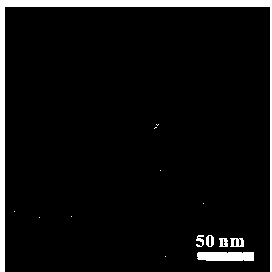Preparation method for monodisperse bismuth nano-particles with controllable particle sizes
A monodisperse, bismuth nanotechnology, applied in nanotechnology and other directions, to achieve the effects of simple operation, controllable reaction conditions and uniform particle size
- Summary
- Abstract
- Description
- Claims
- Application Information
AI Technical Summary
Problems solved by technology
Method used
Image
Examples
Embodiment 1
[0019] 1. Preparation of tetrahydrofuran solution of bis(trimethylsilyl)aminobismuth:
[0020] At 0°C (such as in an ice-water bath), 2.15 g of lithium bis(trimethylsilyl)amide (Li[N(SiMe 3 ) 2 ]) was dissolved in 20 mL of diethyl ether solution to form a diethyl ether solution of lithium bis(trimethylsilyl)amide.
[0021] Dissolve 1.35 g of bismuth trichloride in a mixed solution of 20 mL of diethyl ether and 5 mL of tetrahydrofuran, and slowly add it dropwise to the diethyl ether solution of lithium bis(trimethylsilyl)amide, and magnetically stir for reaction 1 Hour.
[0022] After the reaction was completed, the reaction solution was filtered, and the yellow-green filtrate was rotary evaporated. Then, 10 mL of pentane was added to dissolve, and after filtration, the rotary evaporation was performed again to obtain a yellow powder, bis(trimethylsilyl)aminobismuth, which was dispersed into tetrahydrofuran to form a tetrahydrofuran solution of bis(trimethylsilyl)aminobismut...
Embodiment 2
[0030] 1. Preparation of tetrahydrofuran solution of bis(trimethylsilyl)aminobismuth:
[0031] At 0°C (such as in an ice-water bath), 2.15 g of lithium bis(trimethylsilyl)amide (Li[N(SiMe 3 ) 2 ]) was dissolved in 20 mL of diethyl ether solution to form a diethyl ether solution of lithium bis(trimethylsilyl)amide.
[0032] Dissolve 1.35 g of bismuth trichloride in a mixed solution of 20 mL of diethyl ether and 5 mL of tetrahydrofuran, and slowly add it dropwise to the diethyl ether solution of lithium bis(trimethylsilyl)amide, and magnetically stir for reaction 1 Hour.
[0033] After the reaction was completed, the reaction solution was filtered, and the yellow-green filtrate was rotary evaporated. Then, 10 mL of pentane was added to dissolve, and after filtration, the rotary evaporation was performed again to obtain a yellow powder, bis(trimethylsilyl)aminobismuth, which was dispersed into tetrahydrofuran to form a tetrahydrofuran solution of bis(trimethylsilyl)aminobism...
Embodiment 3
[0041] 1. Preparation of tetrahydrofuran solution of bis(trimethylsilyl)aminobismuth:
[0042] At 0°C (such as in an ice-water bath), 2.15 g of lithium bis(trimethylsilyl)amide (Li[N(SiMe 3 ) 2 ]) was dissolved in 20 mL of diethyl ether solution to form a diethyl ether solution of lithium bis(trimethylsilyl)amide.
[0043] Dissolve 1.35 g of bismuth trichloride in a mixed solution of 20 mL of diethyl ether and 5 mL of tetrahydrofuran, and slowly add it dropwise to the diethyl ether solution of lithium bis(trimethylsilyl)amide, and magnetically stir for reaction 1 Hour.
[0044] After the reaction was completed, the reaction solution was filtered, and the yellow-green filtrate was rotary evaporated. Then, 10 mL of pentane was added to dissolve, and after filtration, the rotary evaporation was performed again to obtain a yellow powder, bis(trimethylsilyl)aminobismuth, which was dispersed into tetrahydrofuran to form a tetrahydrofuran solution of bis(trimethylsilyl)aminobismut...
PUM
 Login to View More
Login to View More Abstract
Description
Claims
Application Information
 Login to View More
Login to View More - Generate Ideas
- Intellectual Property
- Life Sciences
- Materials
- Tech Scout
- Unparalleled Data Quality
- Higher Quality Content
- 60% Fewer Hallucinations
Browse by: Latest US Patents, China's latest patents, Technical Efficacy Thesaurus, Application Domain, Technology Topic, Popular Technical Reports.
© 2025 PatSnap. All rights reserved.Legal|Privacy policy|Modern Slavery Act Transparency Statement|Sitemap|About US| Contact US: help@patsnap.com



